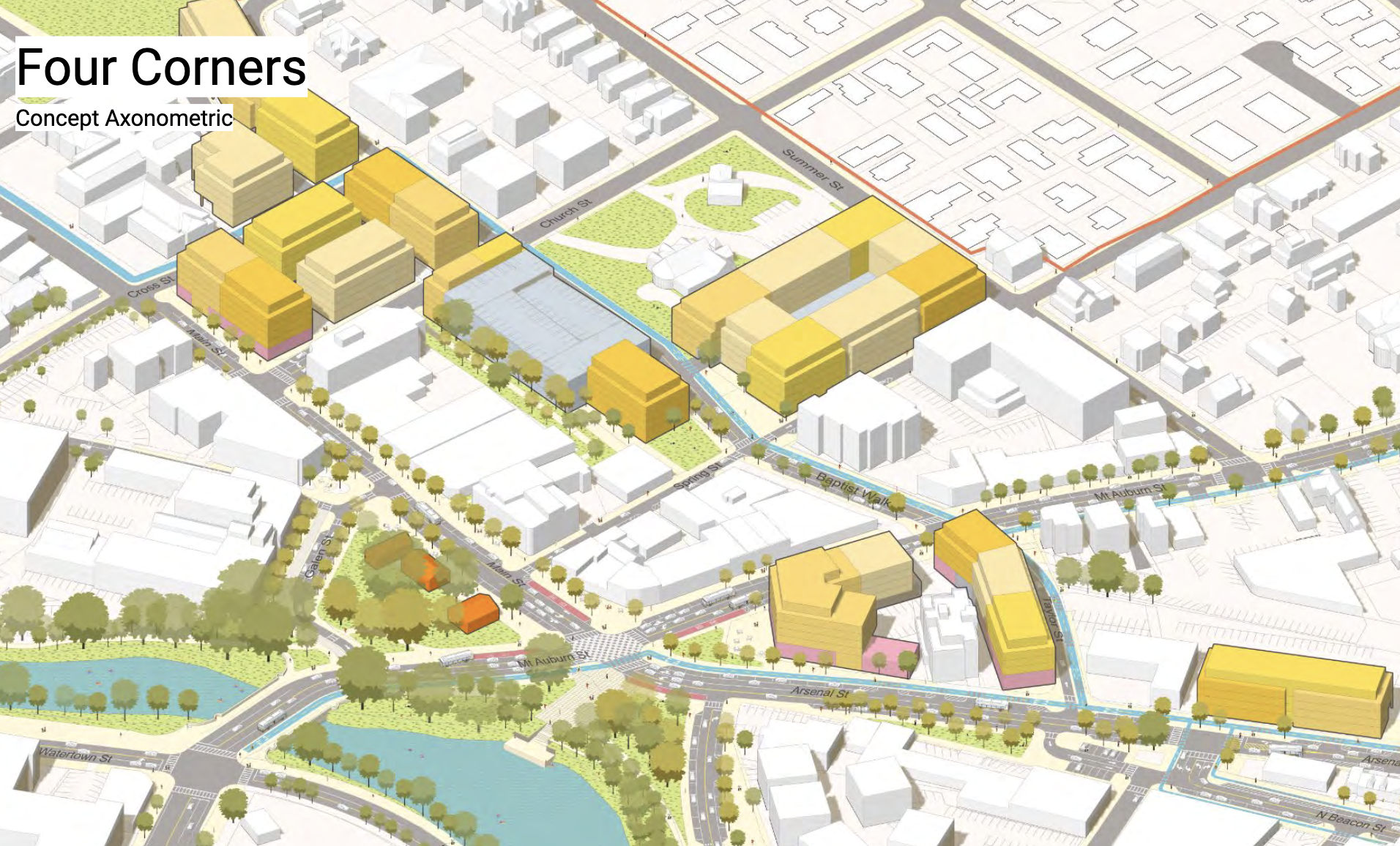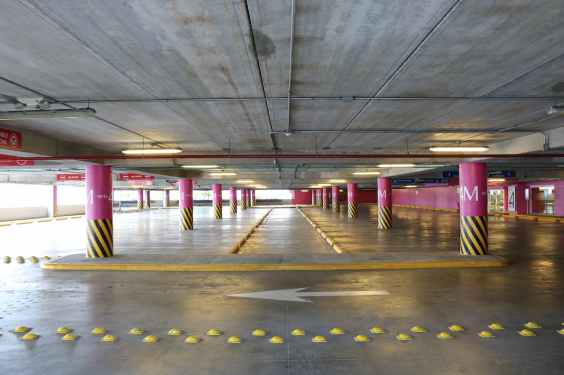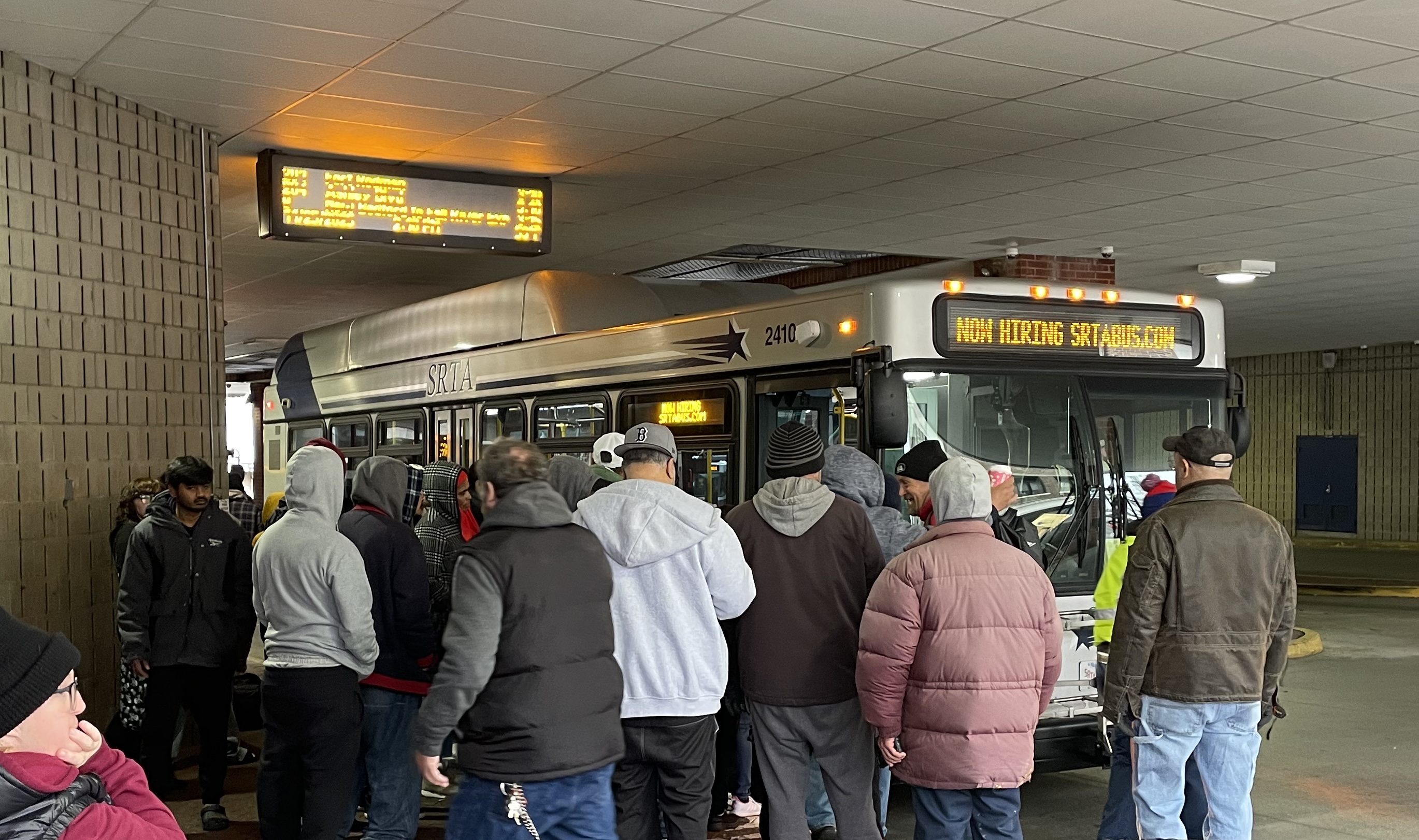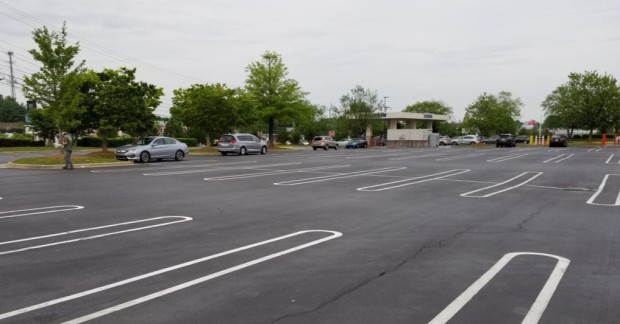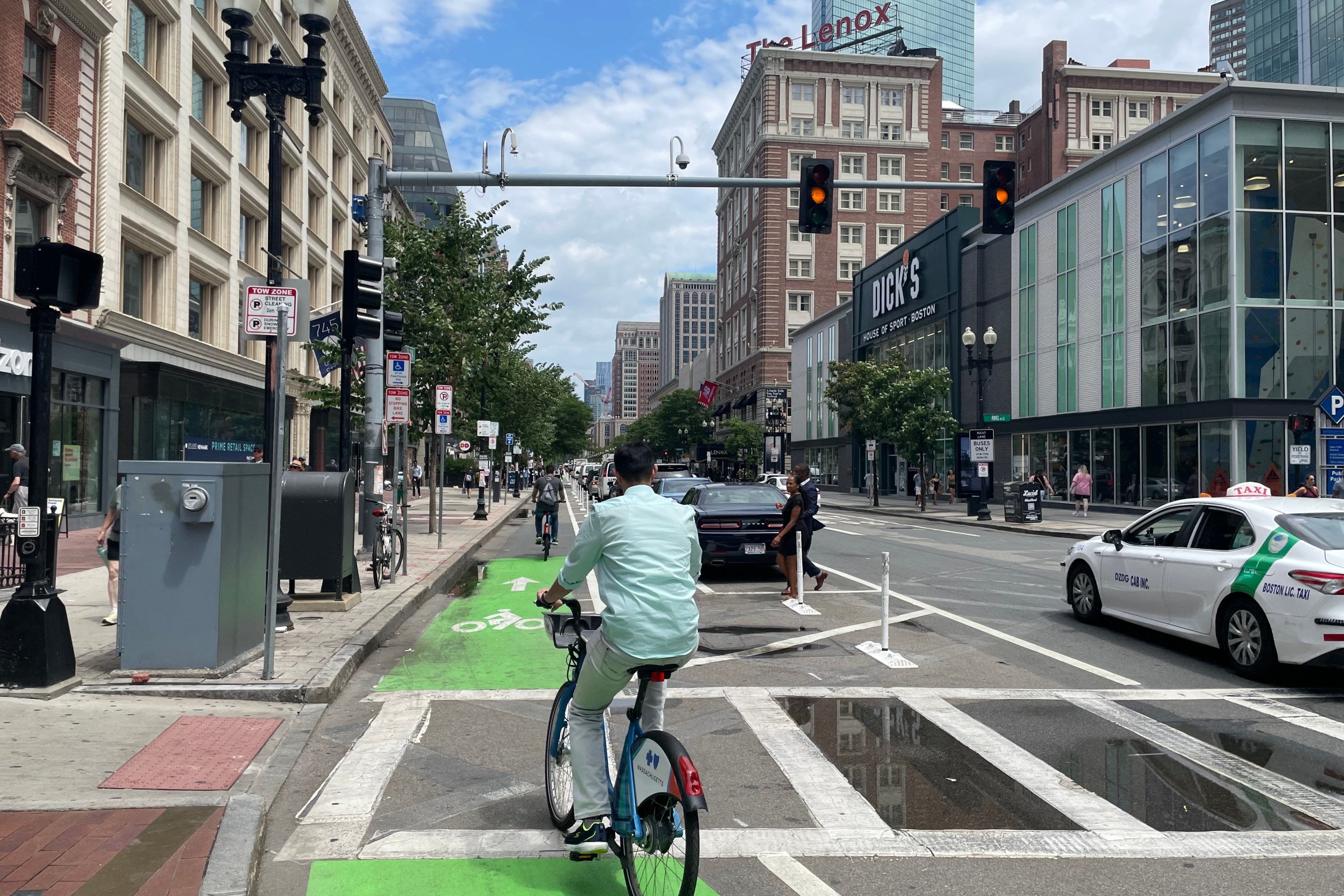This article has been syndicated with permission from Upzone Update, a newsletter that analyzes MBTA Communities Law compliance efforts from zoning expert Amy Dain and the staff of Boston Indicators.
Greater Boston has hundreds of wonderful little downtowns and village centers. Watertown Square should be the envy of them all, but it isn’t. It could be!
Watertown Square has the Charles River; old buildings made of brick and stone containing restaurants, retail, and civic services; frequent bus service; a public green with pretty trees; and arterials connecting it to Boston, Waltham, Newton, Belmont, and Cambridge, as well as to other little villages within Watertown. It is in walking-, biking-, and kayaking-distance to ample jobs, sweet neighborhoods, and many cool places. The Square even has a 24-hour CVS.
But, as the author of Walkable City, Jeff Speck concluded at a public meeting in Watertown last week, “it has never felt like a place for hanging around.”
To correct that, Watertown Square is getting the full treatment from a team of urbanist leaders, including Speck, Loren Rapport and Tim Love from planning and architecture firm Utile, Ralph DeNisco from engineering and design firm Stantec, and economist John Trementozzi from Landwise Advisors.
Also worth noting: Watertown City Manager George Proakis is himself a leader in zoning and land use planning. Proakis has led successful, significant rezoning efforts in both Lowell and Somerville. MBTA staff has also been at the table. Plus, the public is turning out in large numbers for meetings in person and on-line.
For urbanists across the country, it will be an important case study of land use planning. The team is considering the look and feel and function of it all, taking on roads, bridges, bikeways, sidewalks, bus routes, river connection, greenspaces, community gathering places, and of course, MBTA Communities zoning.
As for the rezoning, there are lots of things to take note of. For example, the team is recommending a parking minimum of a half-space per dwelling unit, which is less parking than most suburban zoning laws require. “It encourages people with fewer cars to move here,” Proakis explained.
With public input, the team established criteria for deciding whether parcel redevelopment would need a special permit or be allowed as-of-right. Parcels containing historic buildings or located adjacent to single-family and two-family residential neighborhoods would be designated for special permits. Parcels considered as priorities for transformation, for example ones containing auto-oriented uses, would be zoned as-of-right.
Only the units zoned as-of-right count towards the state’s assigned “unit capacity” for Watertown, listed in the MBTA Communities compliance guidelines as 1,701 units. The unit capacity reached through the parcel-by-parcel designation of as-of-right zoning has come to 3,133 units. In addition, the team is recommending as-of-right zoning for multifamily housing on certain publicly owned parcels; these parcels are not counting toward the unit capacity, per the state’s guidelines. The team’s aim was to zone based on criteria for improving the Square, and not just to meet the minimum capacity number.
At the same time, the team estimates that redevelopment under the proposed zoning might lead to 800-1,000 units, not thousands. The new residents in these homes, as well as in the nearly 2,000 condos and apartments built along the Arsenal and Pleasant Street corridors in the last 20 years, will bring vitality to the redesigned Square and help local businesses.
A big question for zoning reformers is often: how do we use zoning to improve architectural design, the form of buildings? Utile is making several recommendations towards these ends. One innovation in zoning has to do with roof form and something they are calling “+ stories.” The proposed zoning includes a maximum slope for a pitched roof or a minimum setback for a flat roof, requirements designed to make the roof form more interesting and to hide the top story from view of the adjacent sidewalk. Under a pitched or stepped-back roof would be a “partial story” of livable space, the “+ story,” which is illustrated in this graphic, provided by Utile:
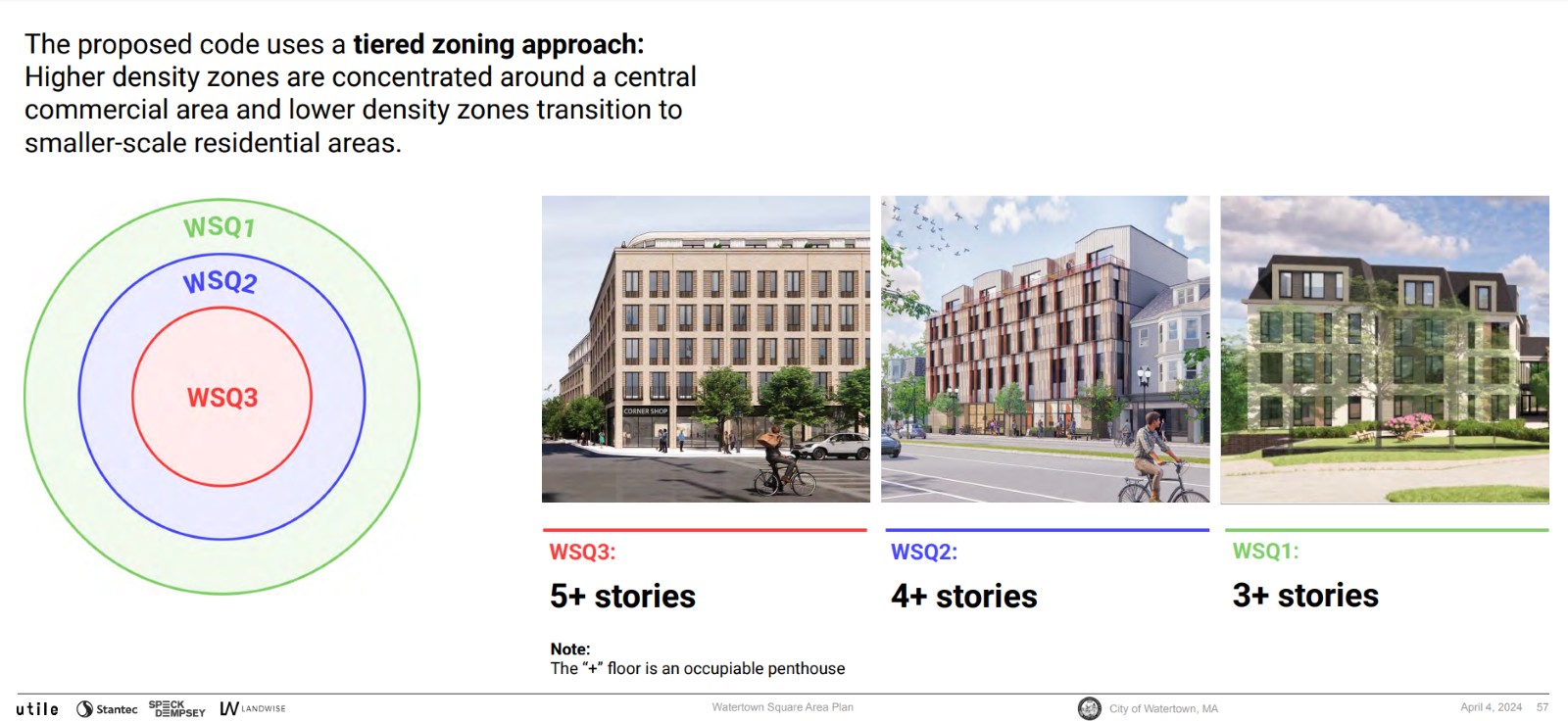
Visit the Water Square Area Plan website for more on the process and details of what’s being considered.
Recent municipal votes to adopt MBTA communities zoning
Abington Town Meeting unanimously passed MBTA Communities zoning to allow multifamily housing in an overlay district around Abington's MBTA commuter rail station.
Bedford Town Meeting passed MBTA Communities zoning by an overwhelming majority, in a hand vote. The Bedford Citizen covered this story. Of special note: Bedford’s MBTA Communities zoning did not include parking minimums! The new zoning districts are on bus routes and near rail trails.
Lincoln Town Meeting also passed MBTA Communities zoning, although with a much closer vote, 52% to 48%, a difference of 40 votes.
Westborough Town Meeting also approved MBTA Communities zoning.
News from other towns
In March, the Tewksbury Planning Board voted to recommend that Town Meeting adopt the proposed MBTA Communities zoning.
Harvard’s Planning Board, with assistance from the regional planning council, wrote a bylaw to designate an 8-acre overlay district on Ayer Road for MBTA Communities zoning. The site was chosen for its proximity to the Route 2 interchange. Also, it would be feasible to connect the site with water and sewer at Devens.
This Salem News article gives updates on several North Shore communities:
In Danvers, Special Town Meeting approved MBTA Communities zoning in February.
Hamilton plans to use “form-based zoning” to shape the form of new development.
Topsfield is considering rezoning 15.8 acres at the intersection of Central Street and Route 1, an area with easy accessibility to the highway and the rail trail.
Ipswich is identifying potential districts and soliciting feedback on the options. Zoning will be voted on at a Special Town Meeting in the fall.
Wenham will hold an information session in May.
Winchester’s Planning Board has issued a zoning plan to come into compliance with MBTA Communities zoning. The proposal includes four overlay districts that start in town center and go north on Main Street. Each district has different standards for floor-area-ratio, maximum height (in feet and stories), setbacks from property lines, and minimum open space.
Banker & Tradesman covered Burlington’s approach to meeting MBTA Communities requirements. Steve Adams reports that a divided Planning Board voted 3-2 in favor of creating five new overlay districts, four of which already include apartments and condominiums. The districts cover 15 parcels and 68 acres. By drawing the districts to cover existing LifeTime Living apartments, the Heritage at Stone Ridge apartments, the Huntington and Tremont apartment complexes, condominiums on Dover and Georgia Drive, the Westgate apartments and the Beacon Village apartment complex, some Planning Board members felt that the new zoning would have the best chance of gaining Town Meeting’s approval. Burlington’s Town Meeting is scheduled for May 13.
Wellesley will likely hold a Special Town Meeting later in the year to take up MBTA Communities zoning. Wellesley’s Town Meeting has 240 voting town meeting members who are elected in the annual town election in March. Each of eight precincts elects 30 members to three-year staggered terms.
Mansfield passed a “Phase I” bylaw to comply with MBTA Communities last June. The town has developed a “Phase II” proposal to reach the required minimum zoning capacity. Town Meeting is scheduled to vote on this May 22.
Medway Town Meeting will vote on MBTA Communities zoning on May 13.
Swampscott is preparing to take up MBTA Communities at its May 20 Town Meeting.
Housing Needham held a community meeting to discuss two zoning scenarios, A) Base Compliance and B) Neighborhood Housing. Diverse views on many topics, such as parking minimums, were expressed. Local business owners offered support for the Neighborhood Housing scenario. For example, Steve Volante, co-owner of Volante Farms, said rezoning would ensure “a larger labor pool and a larger customer base” for small businesses.
The Worcester Business Journal issued an editorial in support of MBTA Communities zoning, concluding that the housing shortage is “a challenge impacting us all and may lead to the worst possible outcome: a more exacerbated workforce shortage.” The editorial explains:
“Still, if the Central Massachusetts economy is to expand, including in the strategically important life sciences industry, we need a more robust and educated workforce. Chinese manufacturer WuXi Biologics is building a nearly 200,000-square-foot facility in Worcester and will need 250 employees when it opens in 2025. That’s just the start of the wave of new life sciences companies economic development officials hope to entice to the region. Many of those workers are anticipated to be recent college grads, so it was alarming to see a report from the Greater Boston Chamber of Commerce finding 25% of residents aged 25 to 30 in Greater Boston are looking to leave in the next five years, due to rising rent, home prices, and job availability. While Central Mass. does maintain a price advantage over Boston, the housing and rental market here is incredibly tight, and those same frustrations are likely being felt by our younger workforce.”
The Boston Business Journal reinforced the same sentiments: “Simply put, there are not enough workers who can afford to live near the businesses that desperately need them. That means businesses must become more vocal in the conversations taking place in their towns and advocate for the passage of zoning plans to alleviate their worker shortage.”
The Patriot Ledger offered coverage of the Milton case, in which oral arguments are scheduled for October, before the Massachusetts Supreme Judicial Court. The Boston Globe’s Andrew Brinker has also been covering the case.
Secretary of the Executive Office of Housing and Livable Communities Ed Augustus writes in the Boston Globe about MBTA Communities zoning: “Now is the moment for our state to act on housing. Massachusetts must lead the way.”
CBS News offered analysis of MBTA Communities implementation. The Governor has been emphasizing that if communities fail to rezone, then: “We’re going to see people leave the state and we’re going to suffer for that.”
At a CommonWealth Beacon panel discussion in Quincy, leaders debated the state law. State Representative Russell Holmes pointed out that new housing will take years to get built, and public transit will have time to improve before new residents come.
In other zoning news, there is a new website for Newtonites to look up which properties are suitable for ADUs, based on the zoning.
